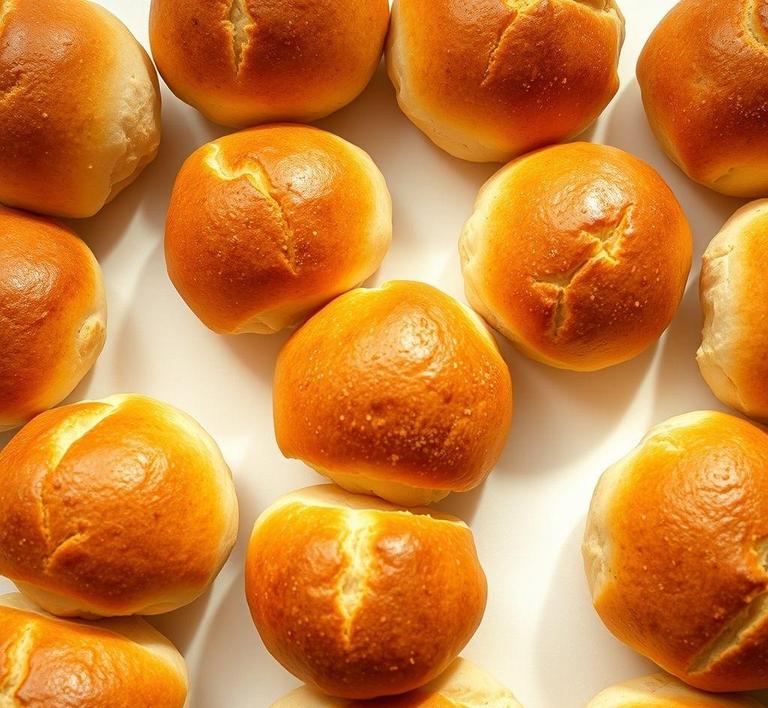Refreezing rolls can be a game-changer when it comes to meal prep and leftovers, especially when you find yourself with more than you can eat in one sitting. But, not all rolls are created equal, and knowing the best way to refreeze them while maintaining that fresh, soft texture is key. Whether you’re dealing with homemade dinner rolls, croissants, or those tasty frozen store-bought varieties, understanding how to properly store, freeze, and later refreeze them can save you both time and money. In this guide, we’ll cover the ins and outs of refreezing rolls so that you can enjoy them just as fresh as the day you made or bought them!
Can You Refreeze Rolls?

When it comes to refreezing rolls, the answer is not as simple as a straightforward yes or no. In fact, it depends on a few factors-such as how the rolls were frozen initially, how they were thawed, and how much time has passed since you first froze them. Let’s break this down.
Rolls are typically made from a combination of flour, yeast, sugar, salt, and water, and their texture is light and airy-factors that can be delicate to preserve when freezing and thawing. The general rule is that you should avoid refreezing rolls once they have been thawed, especially if they have been kept at room temperature for an extended period.
This is because freezing and thawing create moisture changes in the dough, which can affect its structure and texture. When frozen, the water inside the rolls forms ice crystals, which can puncture the cell walls of the dough. Upon thawing, the structure of the roll changes, and when refrozen, these changes can worsen. This process could lead to a soggy, dry, or tough texture, and the rolls might lose their fluffy appeal.
However, if you’ve thawed the rolls in the refrigerator (instead of at room temperature), they are generally safe to refreeze, but their quality might still suffer. In some cases, if the rolls were only briefly thawed or if they were never fully defrosted, refreezing might not have a huge impact on their quality.
How To Refreeze Rolls?
If you’ve decided to go ahead and refreeze your rolls (for instance, if you’ve thawed them in the fridge and haven’t let them sit out too long), it’s essential to follow certain steps to maintain their integrity and safety. Here’s how:
1. Check For Spoilage
Before refreezing, make sure the rolls have not started to spoil. This means checking for any unusual odors, mold, or visible changes to their texture. If they’re safe to eat, move on to the next steps.
2. Wrap Rolls Properly
Proper packaging is key when freezing rolls to ensure they stay fresh and retain their quality. Wrap each roll individually in plastic wrap or aluminum foil, and then place them inside an airtight freezer bag. You want to minimize air exposure to prevent freezer burn, which could affect the texture and taste.
3. Label And Date
Label the bags with the date and type of rolls so you can keep track of how long they’ve been in the freezer. This will also help you use them within a reasonable time frame (usually within 1-2 months for best quality).
4. Flash Freeze (Optional)
For extra care, you can flash freeze the rolls before storing them in a bag. Place them in a single layer on a baking sheet and freeze them for about an hour until they are firm. This prevents them from sticking together and makes it easier to pull out individual rolls when you need them.
5. Refreeze Immediately
Once your rolls are wrapped and secured, place them back in the freezer as quickly as possible. Don’t leave them at room temperature too long before refreezing, as this can allow harmful bacteria to develop.
Quality Impact
Refreezing rolls does come with consequences for quality, and it’s important to understand what might happen when you refreeze them.
1. Texture Changes
The most noticeable effect of refreezing rolls is the change in texture. When frozen and thawed, the dough’s structure is altered due to the formation of ice crystals. These crystals break down the cell walls in the dough, and when refrozen, the rolls may lose some of their original fluffiness. Instead of being light and airy, they could become denser or harder, even after reheating.
2. Loss Of Moisture
Freezing, thawing, and refreezing cause the water content in rolls to change. The moisture can evaporate and redistribute unevenly during the freezing process. As a result, the rolls may become dry or develop an unpleasant chewy texture. Reheating them after refreezing may not fully restore their original softness.
3. Flavor Degradation
Refreezing can also affect the flavor of the rolls. The dough’s subtle flavors might become muted, and they may develop a slightly off taste due to the loss of volatile compounds during freezing. While this is more of an issue with certain types of bread or dough, it can still impact your rolls, especially if they’ve been refrozen multiple times.
4. Freezer Burn
Freezer burn occurs when the food is exposed to air for too long in the freezer. If the rolls are not wrapped tightly, they may develop dry patches and an undesirable texture. While this doesn’t make them unsafe to eat, it significantly reduces their taste and texture.
5. Bacterial Growth Risk
If rolls are left out for too long before refreezing, there’s a risk of bacteria growth. Bacteria thrive in temperatures between 40°F and 140°F (4°C to 60°C), so if the rolls have been thawed and allowed to warm up beyond this range, refreezing them could lead to food safety issues. It’s crucial to make sure the rolls have been stored in the right conditions before refreezing.
While refreezing rolls is technically possible, it should be done with caution. If the rolls have been properly thawed in the fridge, they might still be safe to refreeze, but expect some quality loss in terms of texture, moisture, and flavor. The best advice is to avoid refreezing rolls whenever possible. Instead, it’s better to only thaw the amount you’ll consume within a reasonable time frame. If you find yourself with leftover rolls, reheating them after one freeze and thaw cycle will typically give you the best results. That way, you can still enjoy warm, fluffy rolls without compromising too much on taste and texture.
In the end, while refreezing rolls is doable, it’s generally not the most ideal way to maintain their quality. When in doubt, stick to freezing them just once, and enjoy them fresh when you can!
Is It Safe To Refreeze Rolls?
When it comes to food preservation, the question of refreezing is one that often arises. Rolls, which are a staple in many households, may occasionally be frozen for later use. However, the safety of refreezing them depends on several factors. First, it’s important to understand that the process of freezing and thawing can affect the texture, flavor, and safety of food.
Refreezing rolls is generally safe, but only if certain precautions are taken. The most crucial factor is how the rolls were originally thawed. If they were thawed in the refrigerator and not left at room temperature for an extended period, then refreezing them should pose no significant safety risks. The primary concern when refreezing rolls is bacterial growth, which can occur if they were left out at room temperature for more than two hours before being refrozen.
The key to ensuring safety is controlling temperature. Rolls should be thawed safely, either in the refrigerator or by using a microwave, and never left to sit at room temperature for too long. If the rolls have been kept in a safe temperature range, refreezing them will not introduce new risks. However, each time the rolls are thawed, the texture and moisture content can degrade, which might affect their quality.
Signs That Rolls Should Not Be Refrozen
Before making the decision to refreeze rolls, it’s essential to check whether they are still safe to handle. Here are some signs that rolls should not be refrozen:
- Foul Odor: If the rolls have an off-putting smell, this is a sign that bacteria have started to grow. Refreezing rolls with any noticeable change in smell is not safe, as it could lead to foodborne illness.
- Excess Moisture or Wetness: If the rolls have become overly soggy or wet after thawing, this could be a sign that they’ve absorbed too much moisture, leading to potential bacterial growth. If the rolls appear too wet or slimy, it’s best not to refreeze them.
- Visible Mold: The presence of mold is an obvious sign that the rolls have gone bad. Mold can develop quickly on bread-like products when exposed to moisture, and it cannot be eliminated by freezing or refreezing. If mold is visible, discard the rolls immediately.
- Discoloration: If the rolls have changed color significantly, turning darker or developing spots, this could indicate spoilage. A change in color often signals that the rolls have been exposed to air or have begun to spoil.
- Texture Degradation: If the rolls have become dry, overly crumbly, or tough after being thawed, they will likely not benefit from refreezing. Refreezing such rolls could make them even drier and less palatable.
Common Refreezing Mistakes
While refreezing rolls is not inherently dangerous, certain mistakes can lead to a less-than-ideal result. Here are some common mistakes to avoid:
- Refreezing Without Proper Cooling: One of the most critical mistakes is not allowing the rolls to cool down properly before freezing. If the rolls are still warm when placed in the freezer, they can cause condensation inside the packaging, leading to freezer burn or soggy texture once thawed.
- Thawing at Room Temperature for Too Long: Thawing rolls at room temperature for an extended period before refreezing is a big no-no. Bacteria thrive in the ‘danger zone’ between 40°F and 140°F (4°C to 60°C), so leaving rolls out for more than two hours increases the risk of foodborne illness.
- Not Using Airtight Packaging: Freezing rolls without sealing them in airtight bags or containers can result in freezer burn. Freezer burn occurs when moisture evaporates from the food and leaves ice crystals behind, causing the texture to deteriorate and affecting the flavor. It’s essential to wrap rolls tightly in plastic wrap or foil and place them in a freezer bag or airtight container.
- Refreezing Multiple Times: The more times rolls are thawed and refrozen, the more their quality suffers. Not only does this degrade texture and flavor, but it also increases the risk of bacterial contamination. It’s important to only refreeze rolls once if absolutely necessary.
- Not Labeling the Rolls: When refreezing rolls, it’s easy to forget how long they’ve been stored in the freezer. To avoid confusion and ensure food safety, always label the freezer bags or containers with the date they were frozen. This helps you track how long they’ve been in the freezer and avoid keeping them too long.
Tips And Tricks
If you do decide to refreeze rolls, here are some tips and tricks to ensure that you preserve their safety and quality as much as possible:
- Freeze Rolls Immediately After Purchase or Baking: If you have freshly baked or store-bought rolls that you don’t plan on using right away, freeze them as soon as possible to maintain their freshness. This will prevent them from getting stale and preserve their flavor when thawed and refrozen.
- Wrap Rolls Individually: If you’re freezing rolls in advance, it’s a great idea to wrap them individually in plastic wrap or foil. This way, you only need to thaw the amount you need without having to refreeze the entire batch.
- Thaw Rolls in the Refrigerator: Always thaw rolls in the refrigerator rather than at room temperature. This keeps them at a safe temperature and prevents the growth of harmful bacteria. You can even let them sit in the fridge overnight to thaw slowly for the best results.
- Revive Refrozen Rolls in the Oven: After refreezing and thawing, rolls can often be revived by reheating them in the oven. Preheat your oven to 350°F (175°C) and bake the rolls for 10-15 minutes until they are warm and slightly crispy on the outside.
- Add Moisture During Reheating: If the rolls seem dry after being refrozen and thawed, add a little moisture to the baking process. Place a damp paper towel over the rolls before heating them in the microwave or oven. This can help prevent them from becoming too dry.
- Avoid Refreezing Rolls That Have Already Been Refrozen: Once rolls have been refrozen and thawed, it’s best to avoid refreezing them again. Each cycle of freezing and thawing increases the likelihood of bacterial growth and further degrades their quality.
Conclusion
Refreezing rolls can be done safely, but it requires care and attention to detail. While the process itself does not pose a significant risk, the way the rolls are handled during thawing, freezing, and refreezing plays a critical role in ensuring their safety and quality. By following the right precautions-such as proper cooling, airtight packaging, and safe thawing practices-you can avoid common mistakes that lead to compromised texture, flavor, or safety issues.
However, always be mindful of the signs that indicate spoilage. If your rolls exhibit any unusual odor, texture changes, or visible mold, it’s better to discard them rather than risk consuming something unsafe. By using the tips and tricks provided, you can extend the shelf life of your rolls and enjoy them long after they were first made or purchased, with minimal loss of quality.


